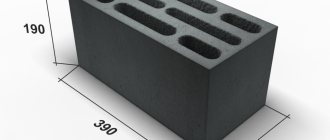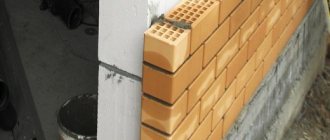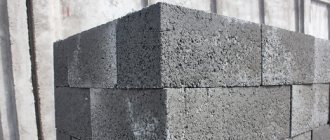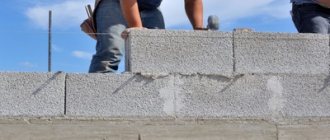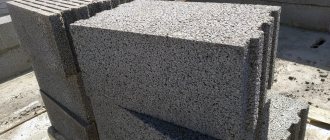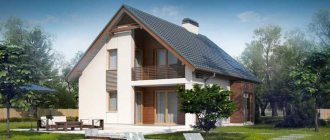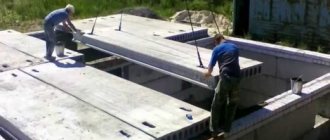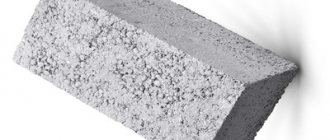In modern construction, expanded clay concrete blocks with cladding are one of the most popular materials. Previously, it was used as bulk ceiling or wall insulation, and as a raw material for the production of insulation boards. Now blocks are produced from it, which are used in low-rise construction for the construction of residential buildings and auxiliary outbuildings.
Due to its performance characteristics and cost, its use allows you to reduce the budget without compromising the quality and aesthetic component of the project.
Definition of expanded clay concrete
Of course, today a huge number of various technologies are used to use internal insulation, but, unfortunately, they have a big disadvantage - they reduce the volume of already small rooms.
Expanded clay concrete block in profile
Therefore, it is best to use a material that, even during construction, will ensure good heat retention in the building. An example of this is expanded clay concrete, a lightweight type of concrete. The filler of this material is expanded clay. This aggregate is the most common because it gives the concrete thermal insulation properties and lightens its weight. Expanded clay received its unique abilities thanks to the clay from which it is made. During the technological process, clay is burned out and a large number of air pores are formed in the expanded clay cavity. Due to its filler, expanded clay concrete has the following properties:
- relatively light weight;
- increased strength and endurance;
- simplicity of the installation process;
- low hygroscopicity, which increases frost resistance;
- high heat and sound insulation;
- economical, this material allows you to reduce the amount of solution;
Expanded clay concrete can be divided into the following categories:
- thermal insulation type - used as a good heat insulator, but the strength properties are underestimated. Monolithic blocks of this type are the lightest, because expanded clay with the largest possible pores is used as a filler. Such expanded clay concrete is suitable for construction buildings that require maximum heat retention, for example, for baths;
Good thermal insulation is one of the main characteristics
Expanded clay concrete block structural type photo
In terms of its thermal insulation properties, expanded clay concrete is on the level between foam concrete and brick.
Specifications
Construction elements based on expanded clay have important technical characteristics:
- Strength. For heat-insulating hollow cores it varies from 5 to 25 kg/sq.cm; for slotted ones - from 35 to 100 kg/sq.cm; for full-bodied people – 100 – 500 kg/sq.cm.
- The weight is voluminous. Hollow ones have 350 – 600 kg/m3; the volumetric weight of slot-holes can be from 600 to 1400 kg/m3; solid structural elements can be from 1400 to 1800 kg/m3.
- The thermal conductivity of the material can range from 0.14 to 0.66 W/(m*K). The greater the proportion of cement in it, the higher the thermal conductivity. To increase the thermal insulation characteristics of walls, hollow elements are preferable, which can compete with wooden beams in retaining heat in the house.
- Frost resistance. For expanded clay blocks with high thermal insulation properties, it ranges from 15 to 50 cycles. In slotted ones - no more than 150. In corpulent ones - no more than 500.
- Hygroscopicity and vapor permeability. The first indicator is from 5 to 10% of the total mass. If plasticizers are added to the mass during production, water absorption is reduced. The second is from 0.3 to 0.9 mg/(m*h*Pa). Depends on the degree of porosity, size and shape of voids. The maximum is for thermal insulation.
- Shrinkage. It ranges from 0.3 to 0.5 mm/m.
- The fire resistance of expanded clay blocks is 3 hours at 1050 ⁰C.
- Soundproofing. A wall made of elements with parameters 590*90*188 mm reduces the sound flow to 45-50 dB.
Low-rise houses are mainly built from expanded clay blocks, but the strength of solid elements allows them to be used for the construction of houses with 12 floors.
Technology for working with expanded clay blocks
The basic principles of building structures made of expanded clay concrete are no different from laying ordinary bricks, and do not require any qualified knowledge. Expanded clay concrete is larger in size than brick, so the installation process is faster and easier.
Technology for working with expanded clay blocks
Manufacturers provide various types of expanded clay concrete, which depend on the purpose:
- The foundations intended for laying are monolithic foundation blocks, measuring 590x400x200 mm. The weight of such products is 50 kg.
- Used for the construction of the plinth are solid expanded clay concrete blocks, the size of which is 590x290x200 mm. There are grooves on the surface of such products, which allow the belt to be reinforced with steel rods.
- For laying interior and load-bearing walls, as well as partitions, hollow brick products with dimensions of 390x190x200 mm and 590x400x200 mm are used.
Let's consider step by step how a house is built from a building material - expanded clay concrete.
Laying the foundation
An example of a foundation made using expanded clay block laying technology
To build an ordinary building from expanded clay concrete monoliths, you need to provide a strip foundation. If a basement structure is being prepared, it is better to use concrete blocks for the foundation. The foundation laying technology is standard and does not necessarily require the assistance of specialists. But the quality of execution and adherence to technology must be at their best. Expanded clay concrete allows you to save on laying the foundation, without losing the strength parameters of the structure, because building blocks, due to their lightness, do not require a bulky and expensive foundation.
For formwork, you can use a special polystyrene foam structure, or you can use wooden panels as usual. The foundation pit is prepared according to the dimensions of the future design project, into which the finished formwork will be installed.
IMPORTANT! To fill the foundation, you need to use only high grade cement, not lower than M400.
Before the start of the main work, the foundation must be maintained for a period of two weeks to three months after laying, in order to achieve the required strength.
Wall arrangement
An example of a wall made of expanded clay blocks
It is possible to erect a building from expanded clay concrete in a fairly short time. You need to prepare the following tools:
- trowel;
- mallet;
- control cord;
- wooden corner;
- kneading container;
To prepare the solution, you will need the following ingredients - cement, purified sand and water. Use only high-quality materials, the strength of the entire future structure depends on them. The ratio of components is selected relative to the brand of cement, but the optimal option is one to three. The resulting mixture should have a sour cream consistency. This condition will not create fluidity in the seams and will provide good adhesion of the solution to the product. The solution can be supplemented with special additives to increase certain qualities of the solution, for example, strength or frost resistance. Construction supermarkets sell specialized adhesive mixtures that can also be used for laying expanded clay concrete.
How to properly lay expanded clay concrete blocks
The installation process is not much different from the construction of brick buildings. However, as mentioned above, masonry is a much simpler process that does not require much time or effort. However, you should adhere to some rules
So, the usual cement mixture acts as a solution. But in order for its adhesion to the block to be better, the latter must be moistened before work. The laying itself begins from the corners of the building, and two layers of roofing material are laid between the first row and the concrete base for waterproofing purposes.
The masonry is very simple - after applying a layer of mortar to the blocks, we install it in place, stepping back from the edge of the adjacent element by about five centimeters. After this, all that remains is to slide the block into place, thus ensuring complete tightness of the structure.
Important! The strength of a wall built on the basis of expanded clay concrete blocks greatly depends on the quality of the seams between the latter. To strengthen this part of the wall, you can use metal reinforcing mesh.
It is extremely important during construction to correctly lay the first row. So it is necessary to carefully check the foundation surface for unevenness, and, if necessary, correct the situation by applying different thicknesses of cement mortar.
Cladding with expanded clay bricks
This type is used most often for facing work because it has the best quality factors.
Layout of expanded clay concrete walls
This may include:
- Durability, the service life of this material exceeds 30 years.
- Can withstand fairly low temperatures.
- Moisture resistance, which is ensured by a low coefficient of moisture absorption.
- The surface of the facing brick has good wear resistance.
- Beautiful appearance.
- Practicality, the use of such cladding does not require additional maintenance.
What consumables and tools will be required?
External thermal protection of a building is not complicated; rare tools and building materials are not required for its implementation.
For high-altitude work, the developer must rent scaffolding , prepare a carpenter's kit for making sheathing, a drill, an angle grinder, measuring equipment: a ruler and a level, as well as spatulas - narrow and serrated, a construction knife, containers for preparing glue.
For materials, the developer must purchase dowel nails, glue, insulation, fiberglass mesh, primer, vapor barrier membrane and construction tape. Depending on the chosen exterior finishing option, you may need: siding or plaster for the facade.
Working with facing bricks
This brick is superior to ordinary ceramic brick in its performance. The technology is as follows. Limestone is mixed with cement and water; if it is necessary to change the color, a dye is used. And under high pressure of 300 tons the pressing process takes place. Thanks to its production technology, hyperpressed brick has improved properties:
Brick wall cladding
- high strength;
- excellent frost resistance;
- low moisture absorption, lower than that of ceramic bricks;
- correct geometric shape, facilitating the work of the stacker;
- hyperpressed brick is an environmentally friendly material, only limestone and cement are used in production;
- due to good interaction with the solution, the finished structure is similar to a monolith;
- Application in structures with weight restrictions is impossible, because it is quite heavy.
- This brick has high thermal conductivity, so additional insulation will be required before cladding.
- Working with this material requires special care; due to adhesion, it will be almost impossible to remove excess solution from the surface.
Facing with such bricks allows you to create a variety of decorated elements. There are a large number of shades and shapes of hyper-pressed block, which will allow you to decorate the facade of your house in an original way.
Expanded clay
This facing brick entered into facing work relatively recently. The production technology is identical to expanded clay concrete, only expanded clay granules are used as a filler. It competes at the proper level with other facing materials in the following abilities:
Expanded clay brick photo
- strength, it resists external and mechanical influences and its own weight;
- frost resistance, withstands high frosts;
- service life is at least 15 years;
- it has excellent thermal insulation;
- sound absorption is at the proper level;
- resistance to all kinds of fungi and mold.
This material also has its own characteristics:
- The weight is very small with product dimensions of 60x30x40cm;
- The surface of expanded clay brick is embossed, except for the back sides, which ensure even laying;
- When laying, this product requires an air cushion between the wall of the house and the facing layer, the absence of which will lead to the accumulation of moisture;
Let's consider the process of lining with one of the above materials - facing bricks.
Cladding of expanded clay concrete
The main task of facing work is decoration and protection from precipitation, closing open pores on the surface of the blocks. There are no special instructions for facing expanded clay concrete; you just need to take into account certain recommendations. The main wall must have a connection with the facing layer. It is mandatory to have a foundation for this layer; you can use a common base with a load-bearing wall. Before carrying out such work, you need to make sure that the erected wall structures have achieved the required strength. For this process, you will need the same tools and solution as for laying expanded clay concrete blocks.
Important point! A coating made of such bricks will be “cold”, so before starting the cladding process, expanded clay concrete must first be insulated.
The following can be used as insulation:
- mineral wool;
- Styrofoam;
- fiberglass boards;
Walls to be covered must be:
- cracks are rubbed out and sealed with mortar;
- cleared of concrete and debris;
- have the strength required by the design;
- deviations of the wall surface relative to the level should not exceed 5 mm;
Application
Expanded clay blocks must be used in accordance with their intended purpose. Hollow ones are classified as materials with low thermal conductivity and are used as insulation or for the construction of private houses with increased thermal insulation properties. Structural and heat insulating (slit) have a wider range of applications.
Strength and low thermal conductivity allow them to act as the main building elements in residential and commercial buildings, or as heat insulators.
Solid – building material with high strength characteristics. It is used in construction as a structural element in the construction of residential buildings, industrial buildings, for the construction of overpasses and bridges.
What is expanded clay concrete and its properties
Expanded clay concrete was invented back in the Soviet Union. It replaced the usual cinder blocks in construction. This material consists of:
- Cement.
- Water.
- Clay that is first foamed and then fired.
- Thanks to its production technology, expanded clay concrete has excellent thermal insulation properties and, as a rule, does not require additional insulation.
- Finishing work on such a building material must be carried out without fail, since it does not have an attractive appearance.
For such purposes, various finishing methods are used:
- Despite this, brick cladding of a house made from expanded clay blocks is the most popular. This facing material has a large selection of types and shades, which differ significantly in their properties and methods of use.
- A house made of expanded clay block with brick cladding is very durable and reliable. It has excellent sound and heat insulation properties. The service life of such a structure is at least 60-80 years.
Advice. Despite the fact that expanded clay concrete itself is a warm material, still in those regions that have a very cold climate in winter, expanded clay concrete walls with brick lining must be subjected to additional insulation.
- For this, polystyrene foam, polyurethane foam or extruded polystyrene foam are used. We should also not forget that expanded clay concrete has the ability to allow air and steam to pass through. Because of this, it is necessary to make a ventilation gap, especially if the wall is made of expanded clay concrete blocks and is faced with expanded clay concrete brick, and not a simple ceramic or other type.
- The main advantage of expanded clay blocks is that they are large in size, which makes it possible to save on the purchase of building material and not very heavy weight, which allows you to build a base that is not too deep.
- The laying of this material can be done similarly to brick, only here it is worth considering that in two planes of the material there are small holes that increase the vapor permeability of expanded clay concrete and they must be properly protected - plastered or simply covered with various finishing materials. The work itself on the construction of houses made of expanded clay blocks is characterized by the use of concrete mortar, which contains a small volume of purified sand.
- Very durable and reliable, as they can withstand significant mechanical and physical loads.
- Frost-resistant - can withstand very low temperature changes.
- Fire resistant - can resist direct fire for a long time.
- Practical and economical - due to its size, building a house does not cost too much money, and the process itself is very fast.
- Environmentally friendly - this indicator in the characteristics of the material is the most important. Expanded clay concrete is safe for human health and does not harm the environment.
Note. It is also worth considering that the total price of building a house from expanded clay concrete will be several times lower than when using brick or other stone. Everything is influenced by the size of the expanded clay concrete block.
Facing expanded clay concrete blocks
Previously, such blocks were not very beautiful in appearance, and therefore their finishing inside and out was almost mandatory. However, now everything has changed - materials that already have external cladding have appeared on the market, and also colored ones. The number of options at the moment is so large that you can choose the ideal solution for yourself, regardless of the design idea. But if you still choose options for carrying out facing work yourself, then the material itself is very convenient for this, and allows you to carry out the process in several ways.
Plastering works
The surface of such a block is attractive due to its roughness, which makes it possible to adhere well to plaster for external use. In addition, the latter is usually made on the basis of cement, which makes it related to both the building blocks themselves and the mortar that fixes them.
In the case of interior work, gypsum plaster will be more preferable, to which concrete contact elements are often added already at the production stage to ensure the best adhesion to the surface. The use of the gypsum version is attractive because such a plaster layer is lighter and warmer, since it has a lower density.
Important! If it is necessary to lay a thick layer of plaster, it is necessary to carry out reinforcement work. At the same time, it is better to use a galvanized metal mesh on the outside, but on the inside, a polymer-based mesh would be an ideal solution, since it is much easier to work with.
Facing
There are several options for carrying out this work. Expanded clay concrete walls are suitable for the most varied types of cladding in terms of weight and technical characteristics. It is worth considering that in this case the thermal insulation is located on the outside, which makes the insulation as effective as possible. Both tile materials, such as polystyrene foam or polystyrene foam, and roll materials such as mineral wool and the like can be used as cladding.
The most popular methods of cladding such walls are ceramic or clinker facing bricks, as well as numerous curtain wall systems. The latter are assembled on a frame and can have any surface, allowing you to get the effect of wooden or stone walls. Finally, siding is widely used.
Brick for cladding a house made of expanded clay blocks
There are several types of such material that are very widely used for finishing expanded clay concrete:
- Expanded clay concrete brick.
- Facing brick.
The last type of brick is also called facade or front.
Expanded clay concrete brick and its properties, characteristics
Expanded clay concrete facing bricks have become popular relatively recently. All this is due to the fact that many of its color designs have appeared. What is this type of brick? It's quite simple. It is very similar in production technology to expanded clay block. Only it contains expanded clay in granules. He:
- Durable - not able to deform under the influence of physical and mechanical force and under its own weight.
- Frost-resistant, as it can easily withstand the effects of very low temperatures and various types of weather conditions.
- It is not subject to rotting and various fungal diseases.
- It is an excellent heat and sound insulating material.
- Practical, since the surface is moisture-resistant and does not absorb dirt and dust (it does not need to be cleaned).
- Durable, as its service life is at least 10-15 years.
- In addition to all this, facing walls made of expanded clay blocks with bricks made from similar raw materials is environmentally friendly.
- The brick itself of this type also has large dimensions of 60x30x40 cm. Its weight is very small, which will not make it possible to place additional load on the base of the building.
- The surface of expanded clay concrete brick is embossed and smooth on the back sides. With its help, even laying of the material is ensured. It is possible to use it in a torn stone finish.
- Expanded clay concrete brick breathes and its installation requires an air cushion between the wall and the back side of the material. Thanks to it, moisture will not accumulate on the inner surface of expanded clay concrete, which in most cases is the source of mold formation.
What is a facing expanded clay block
Cladding expanded clay concrete block is an environmentally friendly material for the construction of walls. Due to the porous structure of expanded clay, the weight of an individual block is small compared to other materials - brick, cinder block. Foamed clay, which makes up expanded clay, mixed with concrete, gives the material additional strength. Buildings with walls made of expanded clay concrete blocks retain heat well, which is important during the heating season.
A distinctive feature of the material is the decorative facing layer, thanks to which finishing is provided on the outside of the building.
This reduces the time it takes to complete construction work on external walls, carried out at the final stage.
The facing layer is made from a textured mixture of high-hardness concrete with the addition of a coloring pigment. Special equipment makes it possible to produce various forms of the front side - from crushed stone to imitation brick and other decorative materials, including stone, plaster, wood.
Facing brick, its types and properties
Brick lining of expanded clay block can be done:
- Facade (ceramic).
- Silicate.
- Clinker.
- Facing hyper-compressed.
Facing bricks for finishing expanded clay blocks have a number of advantages, they are:
- Brick finishing has an attractive appearance that does not require additional decoration.
- Standard size, only solid or hollow bricks available. The last type is most often used in decoration.
- Moisture resistant, as it is not able to withstand the effects of a humid environment.
- Practical - its surface is not subject to contamination and does not require frequent cleaning.
- Durable - its service life is at least 30 years.
- Frost-resistant - able to withstand very low temperatures.
- Wear-resistant - the surface does not wear out or deform over time.
It is characterized by very easy installation when using cement or concrete mortar.
Installation of facing bricks
Instructions are not required for such work. You just need to follow certain rules and recommendations. Initially, it is worth considering that the cladding must be connected to the main wall of the building and have a foundation, which can be common for both the cladding and the house.
Note. To do this, metal pads are made from thick sheets on the wall. Reinforcement is welded to them, which will be hidden in the concrete mortar during the laying of facing bricks.
To install the facing brick itself you will need:
- A concrete solution that is independently prepared from sand, water and cement in certain proportions. They depend on the size of the container and the quality of the material itself.
- A spatula for applying mortar to the surface of a brick.
- Construction level for smooth and high-quality laying of facing material.
- A coloring pigment, which in some cases is added during the production of concrete mortar in order to give a decorative and original joint to the masonry.
Plaster
The most common and inexpensive option is plaster. Modern compounds have a solid foundation and can last quite a long time. The choice of composition texture is unlimited. Most often a mixture of cement and sand is used. You can strengthen this composition with a metal mesh. But this moment can be excluded. If the mesh is necessary, then it is fixed to the wall with nails and screws, and plaster is applied on top. After completion of the work, facade paint or a layer of decorative plaster is applied on top.
Ceramic facing brick and its properties
Brick cladding of ceramic expanded clay blocks has become popular for a very long time. All this is due to the high quality indicators of this type of material. It has a number of advantages and is able to decorate any structure with its appearance. It has standard sizes and design shades: red and white. In some cases, other colors are also found. Sand-lime brick:
- This type of material is a little outdated at the moment and is not used as often as before.
- It also has excellent quality indicators, only in most cases, under the influence of moisture, sand-lime brick is able to release salt, which appears on the surface and spoils the appearance of the entire facade.
- Cladding a house made of expanded clay blocks with clinker bricks is distinguished by its durability and wear resistance.
- This type of material is a modern analogue of conventional facade brick, only with improved characteristics and properties.
- It retains heat even more and does not allow cold air to pass through.
- It has standard sizes and shades.
Features and types of material
To make expanded clay concrete blocks, similar clay granules are used, which are pre-baked in ovens. In addition to baked clay, the blocks also contain cement mortar.
The clay balls are porous inside, which helps them retain heat and withstand heavy loads. Because of this positive quality, expanded clay has been considered an excellent material for insulation for many years, and is also used for the manufacture of building materials.
Expanded clay blocks are divided into:
- Hollow - have low weight and density. Thanks to these qualities, heat inside the house is retained much better.
- Solid - products that have greater density and strength, due to which they have the ability to withstand maximum loads.
- Slot-shaped - elements with small slot gaps in which free air circulation occurs. This process helps retain heat inside the home.
Installation of a wall made of expanded clay concrete is carried out in a shorter time than from brick, since the elements are much larger in their parameters than brick ones. The cost of expanded clay concrete varies, since prices depend on the amount of raw materials used for the production of the block. So solid elements will be more expensive, since they require more raw materials than hollow ones. They are used mainly for the construction of bases and the top row of walls, so it is not necessary to make all the entire walls from them.
Hollow elements also meet quality standards and create excellent sound and heat insulation. The savings on them are significant, since their cost is low; accordingly, by purchasing such material, you can save money and carry out the construction of the intended building with high quality.
Some time ago, expanded clay concrete needed finishing treatment, since the resulting surface was not decorative. Now manufacturers offer facing elements that do not require additional processing.
Hyper-compressed facing brick
This brick has excellent properties, as it is made by pressing clay dough under high temperatures and only then fired. It is highly durable and reliable. Brick cladding of an expanded clay concrete wall of this type can have various imitations, since on the front side of the material the surface is torn and with different additives. It also has different shades, which creates an original design for the façade of the building.
What types of walls are they used for?
Clad blocks made of expanded clay and concrete are used for the construction of :
- external facade walls of the house;
- baths;
- cottages;
- summer houses;
- country houses;
- gazebos;
- buildings for economic purposes.
With the help of such building material, you can not only build walls, but also simply veneer them. Expanded clay concrete block with decor is perfect for cladding wood-frame houses. However, this building material is not used for the construction of internal walls of the room, as well as for plinths.
Step-by-step description of the technology
Before starting work on creating thermal protection, the walls are very carefully cleaned of debris and the surface is leveled to ensure complete adhesion of the sheets.
Insulation technology for expanded clay block wall structures:
- The walls are primed with the goal of ensuring a high-quality connection of the heat insulator to the surface.
- Prepare a solution that is selected for a specific insulation. The composition is prepared according to the manufacturer's recipe.
- Apply the glue with a notched trowel evenly over the installation area.
- Next, glue is applied to the insulator along the perimeter and in the center.
- Installation is initiated from below, passing sequentially along the perimeter of the building.
- Subsequent rows are made in increments of 1/2 slab.
- A day later, additional fixation is installed with dowels: around the perimeter of the insulator and in the center.
- When using mineral wool, a special vapor barrier layer is installed by installing strips vertically with an overlap of 10 cm, which are fixed with construction tape.
- Next comes the finishing touches.
How to properly insulate expanded clay concrete walls from the outside is described in the video:

